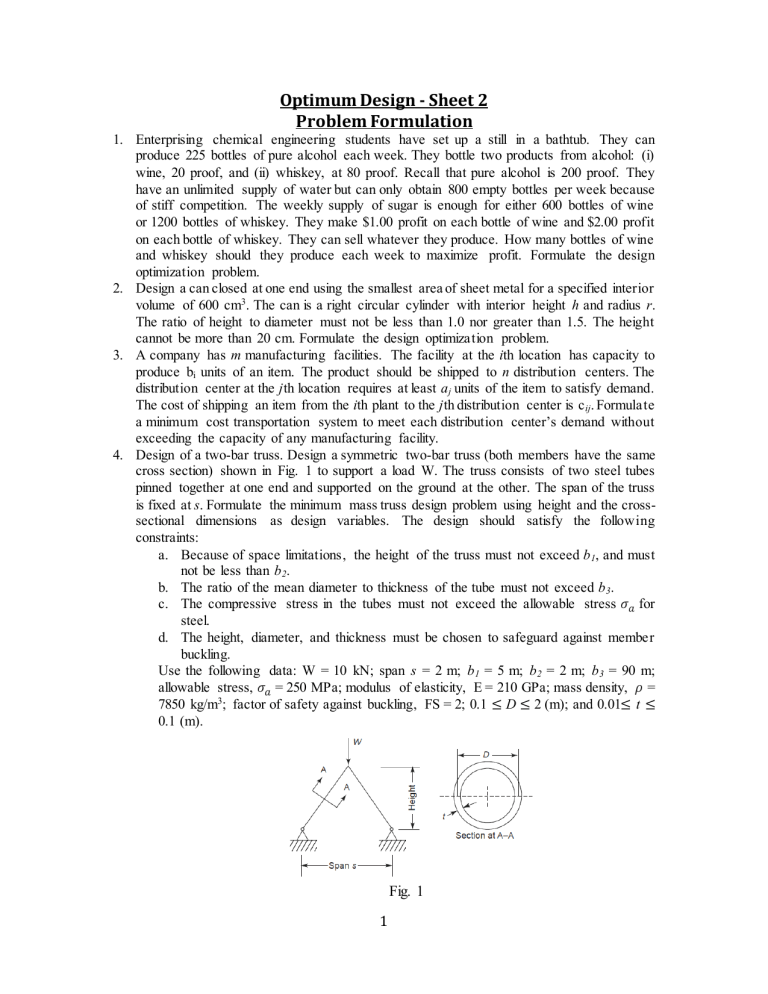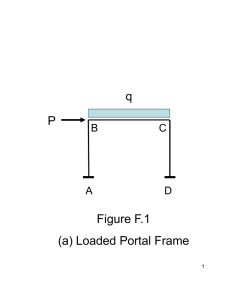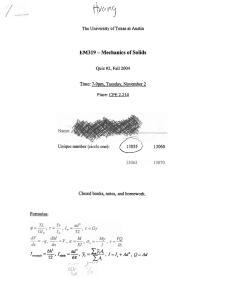
Optimum Design - Sheet 2 Problem Formulation 1. Enterprising chemical engineering students have set up a still in a bathtub. They can produce 225 bottles of pure alcohol each week. They bottle two products from alcohol: (i) wine, 20 proof, and (ii) whiskey, at 80 proof. Recall that pure alcohol is 200 proof. They have an unlimited supply of water but can only obtain 800 empty bottles per week because of stiff competition. The weekly supply of sugar is enough for either 600 bottles of wine or 1200 bottles of whiskey. They make $1.00 profit on each bottle of wine and $2.00 profit on each bottle of whiskey. They can sell whatever they produce. How many bottles of wine and whiskey should they produce each week to maximize profit. Formulate the design optimization problem. 2. Design a can closed at one end using the smallest area of sheet metal for a specified interior volume of 600 cm3. The can is a right circular cylinder with interior height h and radius r. The ratio of height to diameter must not be less than 1.0 nor greater than 1.5. The height cannot be more than 20 cm. Formulate the design optimization problem. 3. A company has m manufacturing facilities. The facility at the ith location has capacity to produce bi units of an item. The product should be shipped to n distribution centers. The distribution center at the jth location requires at least a j units of the item to satisfy demand. The cost of shipping an item from the ith plant to the jth distribution center is c ij. Formulate a minimum cost transportation system to meet each distribution center’s demand without exceeding the capacity of any manufacturing facility. 4. Design of a two-bar truss. Design a symmetric two-bar truss (both members have the same cross section) shown in Fig. 1 to support a load W. The truss consists of two steel tubes pinned together at one end and supported on the ground at the other. The span of the truss is fixed at s. Formulate the minimum mass truss design problem using height and the crosssectional dimensions as design variables. The design should satisfy the following constraints: a. Because of space limitations, the height of the truss must not exceed b 1, and must not be less than b 2. b. The ratio of the mean diameter to thickness of the tube must not exceed b 3. c. The compressive stress in the tubes must not exceed the allowable stress 𝜎𝑎 for steel. d. The height, diameter, and thickness must be chosen to safeguard against member buckling. Use the following data: W = 10 kN; span s = 2 m; b 1 = 5 m; b 2 = 2 m; b 3 = 90 m; allowable stress, 𝜎𝑎 = 250 MPa; modulus of elasticity, E = 210 GPa; mass density, 𝜌 = 7850 kg/m3; factor of safety against buckling, FS = 2; 0.1 ≤ D ≤ 2 (m); and 0.01≤ t ≤ 0.1 (m). Fig. 1 1 5. A beam of rectangular cross section (Fig. 2) is subjected to a maximum bending moment of M and a maximum shear of V. The allowable bending and shearing stresses are 𝜎𝑎 and 𝜏𝑎 , respectively. The bending stress in the beam is calculated as and average shear stress in the beam is calculated as where d is the depth and b is the width of the beam. It is also desired that the depth of the beam shall not exceed twice its width. Formulate the design problem for minimum cross-sectional area using the following data: M = 140 kN· m, V = 24 kN, 𝜎𝑎 = 165 MPa, 𝜏𝑎 = 50 MPa. Fig.2 Cross section of a rectangular beam. 6. A vegetable oil processor wishes to determine how much shortening, salad oil, and margarine to produce to optimize the use of his current oil stock supply. At the present time, he has 250,000 kg of soybean oil, 110,000 kg of cottonseed oil, and 2000 kg of milk base substances. The milk base substances are required only in the production of margarine. There are certain processing losses associated with each product; 10% for shortening, 5% for salad oil, and no loss for margarine. The producer’s back orders require him to produce at least 100,000 kg of shortening, 50,000 kg of salad oil, and 10,000 kg of margarine. In addition, sales forecasts indicate a strong demand for all products in the near future. The profit per kilogram and the base stock required per kilogram of each product are given in Table 1. Formulate the problem to maximize profit over the next production scheduling Period. Table 1. 2 7. Answer True or False: a. Design of a system implies specification for the design variable values. b. All design problems have only linear inequality constraints. c. All design variables should be independent of each other as far as possible. d. If there is an equality constraint in the design problem, the optimum solution must satisfy it. e. Each optimization problem must have certain parameters called the design variables. f. A feasible design may violate equality constraints. g. A feasible design may violate “ ≥ type” constraints. h. A “≤ type” constraint expressed in the standard form is active at a design point if it has zero value there. i. The constraint set for a design problem consists of all the feasible points. j. The number of independent equality constraints can be larger than the number of design variables for the problem. k. The number of “≤ type” constraints must be less than the number of design variables for a valid problem formulation. m. The feasible region for an equality constraint is a subset of that for the same constraint expressed as an inequality. n. Maximization of f (x) is equivalent to minimization of 1/f (x). o. A lower minimum value for the cost function is obtained if more constraints are added to the problem formulation. p. Let f n be the minimum value for the cost function with n design variables for a problem. If the number of design variables for the same problem is increased to, say m = 2n, then f m > f n where f m is the minimum value for the cost function with m design variables. 8. A cantilever beam is subjected to the point load P (kN), as shown in Fig 3. The maximum bending moment in the beam is Pl (kN·m) and the maximum shear is P (kN). Formulate the minimum mass design problem using a hollow circular cross section. The material should not fail under bending stress or shear stress. The maximum bending stress is calculated as where I = moment of inertia of the cross section. The maximum shearing stress is calculated as Fig.3 Cantilever beam. 3 Transcribe the problem into the standard design optimization model (also use Ro ≤ 40 cm, Ri ≤ 40 cm). Use the following data: P = 14 kN; L = 10 m; mass density, 𝜌 = 7850 kg/m3 ; allowable bending stress, 𝜎𝑏 = 165 MPa; allowable shear stress, 𝜏𝑎 = 50 MPa. 4




